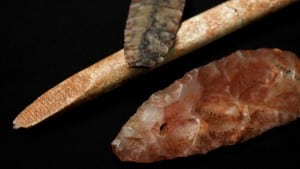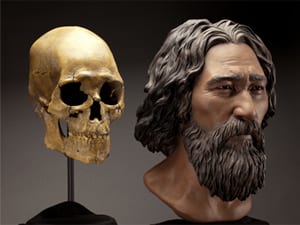
Los Angeles Times reporter Eryn Brown interviewed SMU’s David Meltzer, a professor in the SMU Department of Anthropology in the Dedman College of Humanities and Sciences, about a new large genome-scale study that revealed that the ancestors of all present-day Native Americans arrived in the Americas as part of a single migration wave, no earlier than 23,000 years ago.
The finding addresses the ongoing debate over when and how many times the ancestors of present-day Native Americans entered the New World from Siberia.
Meltzer was a co-author on the study, which was conducted by an international team headed by the Centre for GeoGenetics at the University of Copenhagen. It published online July 23, 2015 in Science.
Meltzer’s research focus is on the origins, antiquity, and adaptations of the first Americans – Paleoindians – who colonized the North American continent at the end of the Ice Age. He focuses on how these hunter-gatherers met the challenges of moving across and adapting to the vast, ecologically diverse landscape of Late Glacial North America during a time of significant climate change.
His research has been supported by grants from the National Geographic Society, the National Science Foundation, The Potts and Sibley Foundation and the Smithsonian Institution. In 1996, he received a research endowment from Joseph and Ruth Cramer to establish the Quest Archaeological Research Program at SMU, which will support in perpetuity research on the earliest occupants of North America.
Meltzer is a member of the National Academy of Sciences and is Henderson-Morrison Professor of Prehistory in SMU’s Dedman College.
The Los Angeles Times article published July 21, 2015.
Read the full article, “Native American origins: When the DNA points two ways.”
EXCERPT:
By Eryn Brown
Los Angeles TimesThis week, two teams of scientists released reports detailing the origins of Native American peoples. Both groups looked at ancient and modern DNA to attempt to learn more about the movements of populations from Asia into the New World, and about how groups mixed once they got here. Both discovered a hint that some Native Americans in South America share ancestry with native peoples in Australia and Melanesia.
But the two groups came to different conclusions when it came to how that DNA with ties to Oceania made its way into the Native American genome.
In a wide-ranging paper in the journal Science, University of Copenhagen Centre for GeoGenetics Director Eske Willerslev and coauthors studied genomes from ancient and modern people in the Americas and Asia. They concluded that migrations into the New World had to have occurred in a single wave from Siberia, timed no earlier than 23,000 years ago. They also calculated that any genes shared with Australo-Melanesian peoples must have been contributed through relatively recent population mixing.
In the meantime, Harvard Medical School geneticist David Reich and colleagues, focusing more closely on the Australo-Melanesian genes in a study published in Nature, came to a different conclusion: that the DNA had to have arrived in the Americas very long ago and that founding migrations occurred in more than one wave.
“It was crazy and unexpected and very weird and we spent the last year and a half trying to understand it,” Reich said on Monday. But “it’s inconsistent to a single founding population. People in Amazonia have ancestry from two divergent sources…we think this is a real observation.”
David Meltzer, an archaeologist at Southern Methodist University in Dallas and a coauthor of the Science paper, said that researchers in his field had been wrestling with the early history of the Americas for centuries — debating when the first settlers arrived here, whether there were pulses of migrations, and so on.
Read the full article, “Native American origins: When the DNA points two ways.”
Follow SMUResearch.com on twitter at @smuresearch.
SMU is a nationally ranked private university in Dallas founded 100 years ago. Today, SMU enrolls nearly 11,000 students who benefit from the academic opportunities and international reach of seven degree-granting schools. For more information see www.smu.edu.
SMU has an uplink facility located on campus for live TV, radio, or online interviews. To speak with an SMU expert or book an SMU guest in the studio, call SMU News & Communications at 214-768-7650.


 $3.78 million awarded by Department of Defense to SMU STEM project for minority students
$3.78 million awarded by Department of Defense to SMU STEM project for minority students Kennewick Man: genome sequence of 8,500-year-old skeleton solves scientific controversy
Kennewick Man: genome sequence of 8,500-year-old skeleton solves scientific controversy At peak fertility, women who desire to maintain body attractiveness report they eat less
At peak fertility, women who desire to maintain body attractiveness report they eat less SMU seismology team to cooperate with state, federal scientists in study of May 7 Venus, Texas earthquake
SMU seismology team to cooperate with state, federal scientists in study of May 7 Venus, Texas earthquake 1st proton collisions at the world’s largest science experiment expected to start the first or second week of June
1st proton collisions at the world’s largest science experiment expected to start the first or second week of June